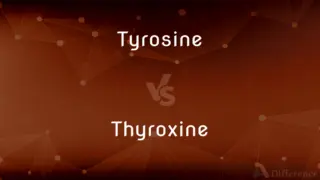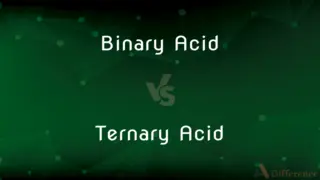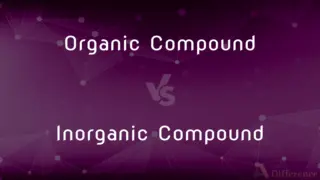Purchase Requisition vs. Purchase Order — What's the Difference?
Edited by Tayyaba Rehman — By Fiza Rafique — Published on December 9, 2023
A Purchase Requisition is an internal document requesting items; a Purchase Order is an official order to a supplier to deliver said items.

Difference Between Purchase Requisition and Purchase Order
Table of Contents
ADVERTISEMENT
Key Differences
A Purchase Requisition is essentially an internal document, a formal request used within an organization to inform the purchasing department about items that are needed. On the flip side, a Purchase Order is an external document, a formal order sent to suppliers to procure a particular quantity of products or services.
Understanding the distinction between Purchase Requisition and Purchase Order is crucial in procurement processes. While the former is a call for approval and initiates the buying process, the latter finalizes the intent to buy and lays out the specifics to the vendor, cementing the transaction's terms and conditions.
In the hierarchy of purchasing, a Purchase Requisition often precedes the Purchase Order. Before making a formal request to an external supplier, departments within an organization raise a Purchase Requisition to get approval for the intended purchase. Once approved, the procurement team issues a Purchase Order to the supplier.
One of the primary reasons organizations use a Purchase Requisition is to maintain internal controls over expenditures. It ensures that funds are utilized appropriately and that there's a legitimate need for the purchase. In contrast, a Purchase Order acts as a legally binding document between the buyer and the seller, ensuring both parties adhere to the agreed terms.
The flow of these documents plays a significant role in inventory and financial management. A Purchase Requisition helps in budgeting, ensuring that the company doesn't overspend. Meanwhile, a Purchase Order is vital for reconciliation, invoice matching, and payment processes, solidifying the agreement's terms and conditions with an external party.
ADVERTISEMENT
Comparison Chart
Nature
Internal document
External, legally binding document
Purpose
Requests items or services within an organization
Orders items or services from an external supplier
Role in Procurement Process
Initiates the buying process
Finalizes and confirms the buying process
Approval Requirement
Requires approval before issuance of a PO
Issued post-approval of a requisition
Legal Implications
Not legally binding
Legally binding between buyer and seller
Compare with Definitions
Purchase Requisition
A Purchase Requisition initiates the procurement process.
Upon identifying a need, the department issued a Purchase Requisition.
Purchase Order
A Purchase Order is an official request to a supplier for goods or services.
The company issued a Purchase Order for 100 laptops.
Purchase Requisition
A Purchase Requisition requires approval before progressing.
The submitted Purchase Requisition is pending senior management's approval.
Purchase Order
A Purchase Order follows an approved Purchase Requisition.
Post the green light on the Purchase Requisition, the team sent out the Purchase Order.
Purchase Requisition
A Purchase Requisition often precedes a Purchase Order.
Once the Purchase Requisition was approved, they proceeded with the Purchase Order.
Purchase Order
A Purchase Order is legally binding between parties.
The supplier couldn't change the terms since the Purchase Order was already signed.
Purchase Requisition
A Purchase Requisition aids in maintaining expenditure controls.
To ensure budget adherence, the team used a Purchase Requisition.
Purchase Order
A Purchase Order confirms the specifics of a transaction.
The Purchase Order detailed the product specifications, delivery date, and price.
Purchase Requisition
A Purchase Requisition is an internal request for items or services.
The manager sent a Purchase Requisition for new office chairs.
Purchase Order
A Purchase Order is used in payment and reconciliation processes.
Accountants matched invoices against the issued Purchase Order for accuracy.
Common Curiosities
What role does a Purchase Order play?
A Purchase Order is an official, external document sent to suppliers, confirming the purchase of goods or services.
Can a supplier change terms after a Purchase Order is sent?
Generally, no. A Purchase Order is a legally binding agreement that solidifies terms between buyer and seller.
Who usually initiates a Purchase Requisition?
Typically, department heads or managers initiate a Purchase Requisition based on their team's needs.
Why might organizations use Purchase Requisitions?
Organizations use Purchase Requisitions for internal control, to ensure appropriate spending and verify the need for a purchase.
How do Purchase Requisition and Purchase Order relate in the buying process?
A Purchase Requisition often precedes and initiates the buying process, while a Purchase Order finalizes and confirms it.
What's a Purchase Requisition?
A Purchase Requisition is an internal document requesting specific items or services within an organization.
Is a Purchase Requisition legally binding?
No, a Purchase Requisition is not legally binding; however, a Purchase Order is.
Can a Purchase Requisition specify a preferred vendor?
Yes, a Purchase Requisition can suggest a preferred vendor, but final vendor selection may be determined during the PO process.
Is every Purchase Requisition always followed by a Purchase Order?
Not necessarily. A Purchase Requisition can be denied or adjusted before a Purchase Order is issued.
Can a Purchase Order be issued without a preceding Purchase Requisition?
While possible, many organizations require a Purchase Requisition first to maintain expenditure controls.
When is a Purchase Order typically issued?
A Purchase Order is typically issued after a Purchase Requisition has been approved.
How are disputes between buyers and sellers usually settled?
Disputes are often referred back to the terms laid out in the Purchase Order, as it's a legally binding document.
How do Purchase Orders help in financial processes?
Purchase Orders are crucial for invoice matching, reconciliation, and ensuring payment terms are adhered to.
Are Purchase Orders only used for tangible goods?
No, Purchase Orders can be used for both goods and services.
How do digital systems impact the Purchase Requisition and Purchase Order processes?
Digital systems streamline and automate the processes, allowing for real-time tracking, approval workflows, and easier reconciliation.
Share Your Discovery

Previous Comparison
TV vs. TS
Next Comparison
DHEA vs. DHAAuthor Spotlight
Written by
Fiza RafiqueFiza Rafique is a skilled content writer at AskDifference.com, where she meticulously refines and enhances written pieces. Drawing from her vast editorial expertise, Fiza ensures clarity, accuracy, and precision in every article. Passionate about language, she continually seeks to elevate the quality of content for readers worldwide.
Edited by
Tayyaba RehmanTayyaba Rehman is a distinguished writer, currently serving as a primary contributor to askdifference.com. As a researcher in semantics and etymology, Tayyaba's passion for the complexity of languages and their distinctions has found a perfect home on the platform. Tayyaba delves into the intricacies of language, distinguishing between commonly confused words and phrases, thereby providing clarity for readers worldwide.
















































